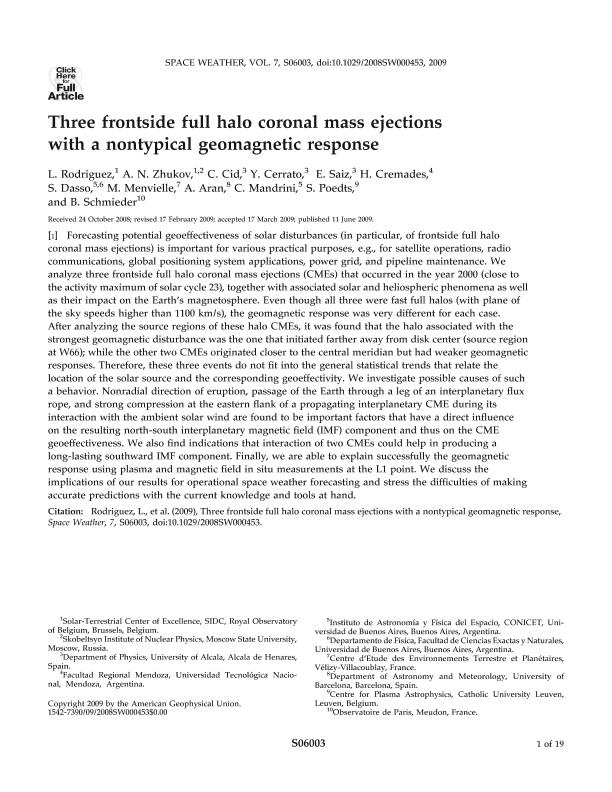Artículo
Three frontside full halo coronal mass ejections with a nontypical geomagnetic response
Rodriguez, L.; Zhukov, A. N.; Cid, C.; Cerrato, Y.; Saiz, E.; Cremades, H.; Dasso, Sergio Ricardo ; Menvielle, M.; Aran, A.; Mandrini, Cristina Hemilse
; Menvielle, M.; Aran, A.; Mandrini, Cristina Hemilse ; Poedts, S.; Schmieder, B.
; Poedts, S.; Schmieder, B.
 ; Menvielle, M.; Aran, A.; Mandrini, Cristina Hemilse
; Menvielle, M.; Aran, A.; Mandrini, Cristina Hemilse ; Poedts, S.; Schmieder, B.
; Poedts, S.; Schmieder, B.
Fecha de publicación:
06/2009
Editorial:
American Geophysical Union
Revista:
Space Weather-the International Journal Of Research And Applications
ISSN:
1542-7390
Idioma:
Inglés
Tipo de recurso:
Artículo publicado
Clasificación temática:
Resumen
Forecasting potential geoeffectiveness of solar disturbances (in particular, of frontside full halo coronal mass ejections) is important for various practical purposes, e.g. for satellite operations, radio communications, global positioning system applications, power grid and pipeline maintenance. We analyze three frontside full halo coronal mass ejections (CMEs) that occurred in the year 2000 (close to the activity maximum of solar cycle 23), together with associated solar and heliospheric phenomena as well as their impact on the Earth?s magnetosphere. Even though all three were fast full halos (with plane of the sky speeds higher than 1100 km/s), the geomagnetic response was very different for each case. After analyzing the source regions of these halo CMEs, it was found that the halo associated with the strongest geomagnetic disturbance was the one that initiated farther away from disk center (source region at W66); while the other two CMEs originated closer to the central meridian but had weaker geomagnetic<br />responses. Therefore, these three events do not fit into the general statistical trends that relate the location of the solar source and the corresponding geoeffectivity. We investigate possible causes of such a behavior. Non-radial direction of eruption, passage of the Earth through a leg of an interplanetary flux rope and strong compression at the eastern flank of a propagating ICME during its interaction with the ambient solar wind are found to be important factors that have a direct influence on the resulting north?south interplanetary magnetic field (IMF) component and thus on the CME geoeffectiveness. We also find indications that interaction of two CMEs could help in producing a longlasting southward IMF component. Finally, we are able to explain successfully the geomagnetic response using plasma and magnetic field in situ measurements at the L1 point. We discuss the implications of our results for operational space weather forecasting and stress the difficulties of making accurate predictions with the current knowledge and tools at hand.
Archivos asociados
Licencia
Identificadores
Colecciones
Articulos(IAFE)
Articulos de INST.DE ASTRONOMIA Y FISICA DEL ESPACIO(I)
Articulos de INST.DE ASTRONOMIA Y FISICA DEL ESPACIO(I)
Citación
Rodriguez, L.; Zhukov, A. N.; Cid, C.; Cerrato, Y.; Saiz, E.; et al.; Three frontside full halo coronal mass ejections with a nontypical geomagnetic response; American Geophysical Union; Space Weather-the International Journal Of Research And Applications; 7; 6; 6-2009; 1-19
Compartir
Altmétricas



